#The Latin Percussion Jazz Ensemble
Text
Live At The Montreux Jazz Festival 1980 (1980, Latin Percussion Ventures, LPV 474)
4 notes
·
View notes
Audio
The Circling Sun - Spirits - glorious new spiritual jazz album from New Zealand
New Zealand’s jazz luminaries have assembled to form an all-star cluster: The Circling Sun.
Channeling spiritual/modal jazz and Latin rhythms, they simultaneously reference the greats such as Sun Ra, Pharoah Sanders and Alice Coltrane, while maintaining a fresh perspective on ensemble dynamics.
Perhaps the group’s name is no coincidence - each instrument seems to be in orbit around the concept of symbiotic synergy - and everyone is given equal space to shine; from a psychedelic Korg, to a delirious saxophone or the gentle ripples of a harp. There’s a huge array of keyboards, skillfully manned by the likes of Guy Harrison and Cory Champion (Clear Path Ensemble), with a standout acoustic piano solo by Harrison on “Plume”.
Not to be outshone, the wind section delivers ecstatic saxophone riffs, fluttering flutes and solid horn choruses throughout. Meanwhile, providing vital foundational support are the percussion (Soundway alumnus Julien Dyne), vibraphone, acoustic bass and full choir arranged by Matt Hunter.
It’s a testament to their harmonious relationship and skill that this debut album instantly sounds like a classic from a group that might have been together a decade.
Artwork: Meurig Rees
8 notes
·
View notes
Text
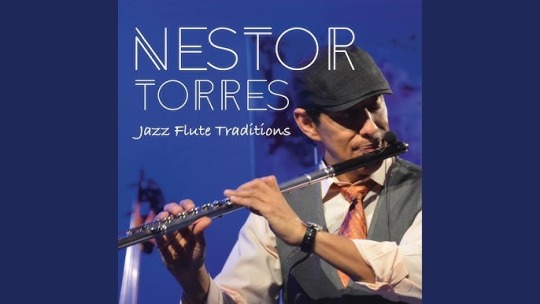
Nestor Miguel Torres (born April 25, 1957) a virtuoso technician Classical, jazz, and composer was born in Mayagüez, Puerto Rico to Nestor Torres Sr., pianist and vibraphone, and Ana E. Salcedo Baldovino-Torres. He skipped two grades, began flute studies at 12, and began studies at Interamerican University. He took classes at the New England Conservatory of Music. He received a BSM from Berklee College of Music at the age of 16. He received an Artist Diploma from the Mannes School of Music.
He performed with the Florida Philharmonic Orchestra and the New World Symphony. He appeared in Cachao: Como su ritmo no hay dos. He released the album, Burning Whispers, which sold more than 50,000 copies.
He married Patricia San Pedro (2002). He was a central attraction at Connecticut’s Greater Hartford Festival of Jazz. Mayor Eddie Perez proclaimed August 19, 2004, as “Nestor Torres Day” with two concerts at Hartford’s Keney Park and Arch Street Tavern.
He played at the World Music Concert during One World Week at the University of Warwick. At the 51st Annual Grammy Awards, he was nominated for “Best Latin Jazz Album Nouveau Latino.
He played at the Herbst Theatre in the San Francisco Civic Center where he performed “Tango Meets Jazz.” He performed at the 21st Central American and Caribbean Games in Mayagüez, Puerto and presented his composition “Saint Peter’s Prayer” for the Dalai Lama at Miami Beach’s Temple Emanu-El. He became the founding director of the Florida International University’s first charanga ensemble, made up of winds, strings, and percussion instruments used to perform traditional and modern versions of folk music from the Caribbean and especially Cuba.
He premiered his composition “Successors” for the concert, “Voices of the Future ” performed with the Miami Children’s Chorus at the New World Center on Miami Beach. In 2017, he released his first album of Latin American classical flute music, Del Caribe, Soy!
His music is a crossover fusion of Latin, Classical, Jazz, and Pop sounds. #africanhistory365 #africanexcellence
0 notes
Text
Finding Your Rhythm: Embark on a Percussive Journey with Drum Lessons by Academies of Music
Introduction: The drums, with their primal beats and rhythmic energy, have been the heartbeat of music for centuries. Whether you dream of laying down the groove in a rock band, keeping time in a jazz ensemble, or exploring the intricate rhythms of world music, mastering the drums opens up a world of musical possibilities. Fortunately, academies of music offer expert drum lessons tailored to all ages and skill levels, providing the perfect opportunity to unleash your inner percussionist.
Exploring Percussive Proficiency: Drum lessons at academies of music are designed to guide students through every aspect of drumming, from basic rhythms and techniques to advanced styles and improvisation. Experienced instructors bring a wealth of knowledge and expertise to the table, offering personalized instruction and feedback to help students reach their full potential. Whether you're a beginner learning your first drum rudiments or an advanced player refining your chops, the curriculum is tailored to meet you where you are and support your growth as a drummer.
Comprehensive Curriculum: Academies of music offer a comprehensive curriculum that covers all facets of drumming. Students learn essential techniques such as stick control, drum tuning, and coordination exercises, laying a solid foundation for musical development. From rock and pop to jazz, funk, and Latin styles, the curriculum encompasses a diverse range of genres and repertoire to suit every taste and interest. Whether you dream of playing blistering drum solos or laying down infectious grooves, there's something for everyone to explore and enjoy.

Building Confidence and Musicality: One of the most rewarding aspects of taking drum lessons at academies of music is the opportunity to build confidence and musicality as a percussionist. Regular performance opportunities, jam sessions, and ensemble playing provide students with a platform to apply their skills in a real-world setting, collaborate with other musicians, and develop their own unique voice on the drums. Whether playing in a band or performing solo, these experiences not only enhance technical proficiency but also foster a sense of creativity, expression, and musicality.
Access to Resources: In addition to expert instruction, academies of music provide access to a wealth of resources to support students on their musical journey. State-of-the-art facilities equipped with drum kits, practice rooms, and recording studios offer an ideal environment for focused practice and exploration. Many academies also offer instrument rental services, making it easy for beginners to get started without the upfront cost of purchasing a drum set.
Conclusion: In conclusion, drum lessons offered by academies of music provide a structured and supportive environment for aspiring percussionists to develop their skills, express their creativity, and achieve their musical goals. Whether you're a beginner with a passion for rhythm or an advanced player seeking to take your drumming to the next level, there's no better time to embark on your percussive journey. So grab your sticks, sit down at the kit, and let the rhythm move you as you explore the world of drumming.For more details visit our website: www.academiesofmusic.com
#Piano Lessons#Guitar Lessons#Violin Lessons#Drum Lessons#Voice Lessons#Viola Lessons#Cello Lessons#Music Lessons#Instrument Rentals#Trumpet Lessons#Trombone Lessons#Clarinet Lessons#Saxophone Lessons#Ukulele Lessons#Flute Lessons
0 notes
Text
Drumming for Beginners: A Comprehensive Guide to Toronto Drum Lessons
Introduction:
The heartbeat of music often lies in the rhythmic cadence of drums, and for aspiring drummers in Toronto, there's no better place to embark on a percussive journey than through the comprehensive Toronto Drum Lessons for beginners at Greater Toronto Music School. Whether you're drawn to the primal beats of rock, the syncopated rhythms of jazz, or the infectious grooves of pop, this guide illuminates the path for beginners eager to dive into the world of drumming in Toronto.
The Beat Begins:
Greater Toronto Music School welcomes beginners with open arms, offering a conducive environment where the art of drumming is demystified. The school's seasoned instructors guide novices through the fundamentals, from understanding drum kit components to mastering basic beats. This foundational knowledge sets the stage for a rhythmic exploration that transcends musical genres.
Personalized Instruction:
Recognizing that each aspiring drummer is unique, Toronto Drum Lessons at Greater Toronto Music School embrace a personalized approach. Instructors tailor lessons to suit individual learning styles and pace, ensuring that beginners not only grasp technical skills but also develop their own expressive flair. This tailored guidance fosters a sense of confidence and accomplishment, motivating students to progress in their musical journey.
State-of-the-Art Facilities:
Greater Toronto Music School boasts state-of-the-art facilities, including well-equipped drum rooms that provide students with hands-on experience on professional-grade drum kits. This immersive environment enhances the learning experience, allowing beginners to familiarize themselves with various drumming styles and techniques while honing their skills on quality instruments.
Also Read: The Benefits of Learning to Play an Instrument: Why Toronto Music Lessons Matter
Beyond the Basics:
Toronto Drum Lessons extend beyond the rudiments, introducing beginners to the diverse world of drumming styles and genres. From rock and jazz to Latin and electronic beats, students have the opportunity to explore and find their rhythmic niche. The goal is not only to teach drumming skills but to inspire a lifelong passion for the instrument.
Performance Opportunities:
At Greater Toronto Music School, the journey of learning to drum culminates in real-world experiences. The school actively encourages students to showcase their progress through recitals, ensemble performances, and even collaborative projects. These performance opportunities not only build confidence but also create a sense of camaraderie among budding drummers.
Conclusion:
For those venturing into the dynamic world of drumming, Greater Toronto Music School's comprehensive drum lessons offer an unparalleled foundation. Aspiring drummers not only acquire the technical know-how but also discover the joy of creating rhythmic magic.
With personalized instruction, state-of-the-art facilities, and performance opportunities, beginners find themselves not just learning to play the drums but becoming an integral part of Toronto's pulsating musical landscape. Whether you're a novice or someone looking to refine your drumming skills, Greater Toronto Music School provides the perfect beat to kickstart your musical journey.
Source: https://www.greatertorontomusic.ca/post/drumming-for-beginners-a-comprehensive-guide-to-toronto-drum-lessons
0 notes
Text
ANAT COHEN/QUARTETINHO, SHELDON CONCERT HALL, 14 OCTOBER 2022
I can’t think of anyone who is so rapturous on stage as ANAT COHEN. She beams in delight at what her bandmates do and is so joyous in her own playing. Oh, she is intense, but there are no grimaces to convince you that this is serious and hard work (though it is).
She reminds me of the Jewish woman I spend my life with when she is a Morris or international folk dancer.
I have enjoyed her at Jazz St Louis with her own band and as part of Artemis (I am seeing their vocalist Cecile McLorin Sauvant and drummer Allison Miller later in the season) and am committed to closely monitoring her musical journey. This ensemble (piano, keyboard, accordion; bass, guitar; vibes and percussion; her clarinets) made up of members of her Tentet goes deeper into Brazilian music. She’s married to a Brazilian and, I think, lived there through the pandemic. Certainly the keyboardist Victor Goncalves (his accordion is a large instrument but had right hand buttons too, not a keyboard—couldn’t see the left hand which might have been sparer) is Brazilian.
My first listen to the album allowed me to capture the atmosphere but not the character of the tunes and there wasn’t anything as catchy as her Happy Song. But live and with it playing as I write, there are familiars to get to know much better (Boa Tarde Pavo, on right now, has a bass riff which she answers on bass clarinet and then soars over). The opening medley of four tunes alternated bass clarinet and really quite lyrical clarinet with vibes and piano, the bass clarinet tunes more atmospheric, the regular clarinet more driving. The segues, her then the bass Tal Maslach, also Israeli then the ensemble as a whole were equally intriguing.
Then the tunes got shorter and James Shipp moved between percussion (not a trap set as the bass drum was vertical like a really big tom tom) and vibes and Maslach did a tune on a seven-string guitar which allowed him to contribute bass lines while doing that wonderful bossa nova guitar thing. They did Going Home based on a Dvorak line and that was the closest to a jazz tune as such.
But Brazilian music has widened the jazz palette for decades, but this deeper dive like the choro encore, reminds of the musical complexity the culture contributes. I think similarly of Miguel Zenon’s album of boleros to make clear a specific element of what Puerto Rico adds, that it’s not just Latin jazz.
Cohen can’t help bring in mideastern and Jewish/klezmer from her own heritage and the instrumentation suggests Balkan and French possibilities too.
No matter what flavors swirl around her, what stands out most is her utter joy, upraised face beaming or delight in what a bandmate has done or happy intensity in looking at them while answering some suggestion they made.
No Happy Song, but so much happiness.
0 notes
Text
Brooklyn Funk Essentials Release video for uplifting single ‘Scream!’
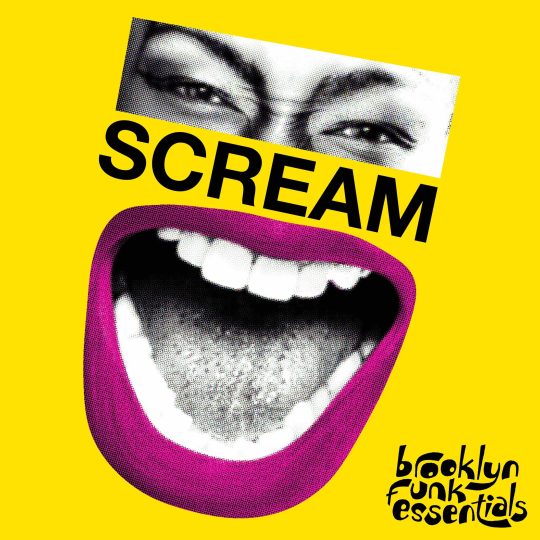
Brooklyn Funk Essentials have released the video for their afrofunk single ‘Scream!’, featuring legendary vocalist Alison Limerick and the full BFE band. The video accompanying the single sees the much loved cult funk ensemble jamming in their element in the studio, with dynamic cuts of Alison moving gracefully across the screen. Watch the new video here
‘Scream!’ is an infectious and uplifting funk and afrobeat jam, a syncopated groove wrapped by powerful Tower Of Power style brass and percussion, with lyrics that see Alison Limerick make a shout for freedom of expression. ‘Scream!’ will be followed by the group’s hugely anticipated seventh studio album ‘Intuition’, which is due November 2022 on Dorado Records. Save & download the new single here
Across 28 years and six albums, Brooklyn Funk Essentials have fused soul, hip hop, spoken word, jazz, Latin, and of course, funk. The band has built up a loyal international cult following since its inception in 1993 by iconic producer Arthur Baker and bassist Lati Kronlund during New York’s buzzing hip hop, jazz and slam poetry scenes in the early 90s, rotating some of the finest musicians, DJs, poets, rappers and singers.
BFE’s celebrated debut album ‘Cool & Steady & Easy’ (Dorado/RCA 1995) scored an underground hit with their version of Pharoah Sanders' ‘The Creator Has a Master Plan’ and featured legends Maceo Parker, The Tower Of Power Horns and Dizzy Gillespie.
Read the full article
0 notes
Text
Miguel Zenón — Música de las Américas (Miel Music)
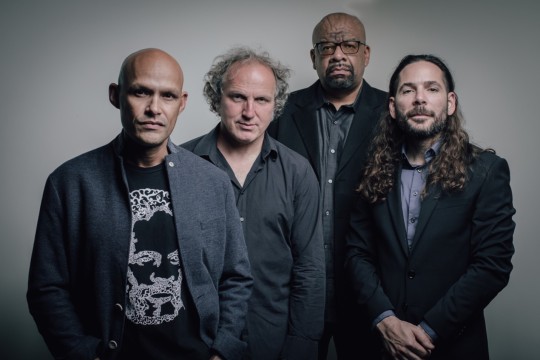
Música De Las Américas by Miguel Zenón
The ambition of Miguel Zenón’s latest recording is evident in the title. Setting that ambition aside for a moment, though, Música de las Américas is a bracing contemporary jazz album punctuated by compelling solos and telepathic give-and-take. Zenón and his long-time musical partners bring his compositions to life in a way that is simultaneously joyful and reverent toward the musical traditions to which they allude. While Zenón’s previous recordings have often tread similar ground, this one has the feel of a capstone or mission statement.
The core quartet of Zenón on alto, Luis Perdomo on piano, Hans Glawischnig on upright bass, and Henry Cole on drums has been together since 2005. They are joined here at various points by one or more percussionists who complement Cole’s sophisticated rhythms rather than overwhelm the sound.
The Spanish titles of the tracks lay out the concept, beginning with opener “Taínos y Caribes,” which references two major Caribbean indigenous groups. Like the other tracks, this one extends to more than seven minutes, providing ample space for the musicians to shine as an ensemble and as soloists. Starting with an insistent piano riff, the track takes flight with a brief solo by Zenón followed by a lengthy one from Perdomo that floats on the solid but ever-evolving rhythmic foundation provided by Glawischnig and Cole. The return of the alto around 3:00 shows Zenón’s debt to Charlie Parker; his lines are lightning-fast but seemingly effortless. A neat stop-time coda then wraps things up.
Next, on the mid-tempo “Navegando (Los Estrellas Nos Guían),” the percussionists join the quartet after a leisurely opening. This is the most overtly “Caribbean” of the tunes, thanks in part also to the one appearance of vocals, which come in near the end of the track, seemingly marking the completion of the journey suggested by the title.
Zenón’s solo (beginning around 1:45) on the next track, the upbeat but intense “Opresión y Revolución,” is a thing of beauty. Through chorus after chorus, he lets one of the percussionists drive him to a near frenzy that then resolves in another standout solo by Perdomo enlivened by his interplay with Glawischnig and Cole.
“Imperios” slows the pace again and pares the lineup back to the quartet, the title referencing the various pre-Columbian empires. Shifting time signatures maintain interest and suggest a link to the next track, “Venas Abiertas,” which shows a hint of the sadness implicit in the title’s reference to the exploitation of the resources of the “New World.” This track builds to a controlled frenzy with a martial beat toward the end perhaps suggestive of the destructive march of progress.
“Bambula” begins with the titular percussion instrument establishing a more playful atmosphere. Zenón stretches his lines out a bit more on this track, especially during the lovely coda, while Cole’s kit locks in seamlessly with the traditional drum. Here especially, the quarter-century of collaboration between Zenón and Perdomo is apparent as they chase and respond to each other.
The last two tracks serve as a kind of summation. “América, El Continente” develops gradually from an eerie piano figure into a kind of celebratory dance, with a nice solo from Galwischnig at 2:40 serving as an inflection point. Closer “Antillano” likewise synthesizes the influences represented in the previous tracks and is, fittingly, the longest of them. Congas lead off, soon joined by the piano with a Latin-flavored melody and more inspired soloing from Zenón. Everything culminates in an exciting percussion breakdown and series of false endings that lend an open-endedness to the recording as a whole.
Zenón here reminds jazz listeners that high-concept recordings need not be weighed down by the underlying theory or polemic. The liner notes helpfully explain the manner in which the leader’s reflections on a millennium or more of American (in the broadest possible sense) history inform his compositions, but this information is incidental to the pleasures that this recording offers. Those who have been following this quartet’s evolution will find much that is familiar here, but Música de las Américas suggests that Zenón, now in his 40s, is just hitting his stride.
Jim Marks
#miguel zenon#musica de las americas#miel#jim marks#albumreview#dusted magazine#jazz#Luis Perdomo#Hans Glawischnig#Henry Cole#caribbean jazz
1 note
·
View note
Photo

Considering the importance of instrumentation to Salsa music, most Salsa bands feature a few players on congas, timbales, cowbells, bongos, maracas, claves, marimba, and vibraphone. The pairing of these instruments creates a variety of distinctive rhythms that are influenced by both African music and Cuban song. Salsa bands create music that is genuinely suitable for dancing.
The Afro-Cuban son montuno, Afro-Cuban percussion, mambo, guaracha, Latin jazz, and Puerto Rican bomba and plena are all combined in this genre, which was founded by Celia Cruz, Bobby Valentn, and Ray Barretto, among others. Salsa ensembles often use one of two formats: the string-based Charanga or the horn-based Son Conjunto.
1 note
·
View note
Text
Light & Motion at the San Francisco International Arts Festival
The more than 100 dancers, musicians, and performers gathering for SFIAF won't let the darkness win.
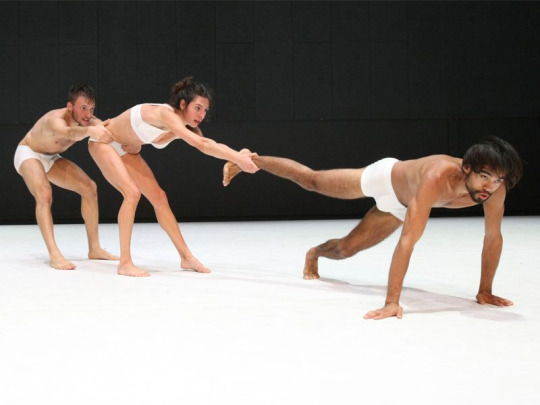
“International” can be an elastic concept. Major League Baseball is ostensibly international in that one of its 30 teams comes from Canada. The International Art Museum of America on Market and Sixth streets is a bizarre, almost cultish gallery space devoted largely to a Pasadena man named H.H. Dorje Chang Buddha III, who claims to be the incarnation of a deity.
But the San Francisco International Arts Festival does more than squeak past the line. It’s a genuinely global endeavor that covers enough of the world’s cultures to be humanity in microcosm. If we ever audition to join a Star Trek-like Federation of Planets, this could be our sizzle reel to prove to the galaxy’s sentient species what Homo sapiens is really made of.
Spanning two full weekends — May 25 – June 4 — SFIAF covers dance, theater and performance art, visual art, and music, with more than 100 artists across all genres. Apropos of the political convulsions shaking the world, yet still full of optimism, this year’s theme is “In the Dark Times, will there also be Singing?” The answer is yes, and there will be plenty else, too.
Choreography is high on the list, with the Japanese trio Scarabe performing Sell Our Body, described as “an intimate piece that employs swift development at close range” to provoke strong audience reactions. Meanwhile, the Bay Area’s own media-savvy STEAMROLLER Dance Company performs Siamese Dream, a take on the classic musical The King and I that’s filtered through Hong Kong kung fu action flicks, questioning constructions of Asian American identity.
If you haven’t experienced much of the percussion-centric Indonesian orchestral ensembles known as gamelan, you have a chance with the Balinese Gamelan Sekar Jaya, which stages the world premiere of In Visible Light with American Larry Reed’s ShadowLight. A borderline-acrobatic performance about an evil king warring for control against a powerful goddess, it’s a myth few Americans know, but it’s as vivid as any thunderbolt from Zeus. American Joe Landini’s theater-video-dance hybrid production (IT WILL BE LOUD) brings the noise — but mostly the heat and light — as the troupe moves about a stage illuminated by a single, handheld beam. And there’s plenty of flamenco, capoeira, and ballet from across Europe and the Middle East.
Musically, things get a little more political. Voodoo Cabaret World Music’s Rise Above Racism — which, at two hours, runs longer than the typical SFIAF program — tackles the religious underpinnings of the music of the African diaspora, from the syncretic spiritual traditions of Haiti and the American South to hymns dedicated to the Catholic icon known as the Black Madonna. Puerto Rico’s Latin Rhythm Boys play a 90-minute show that starts with salsa and ends on Jíbaro, a reference to the culture of the indigenous people who inhabited the island’s mountainous interior, holding out against colonization longer than the coasts could.
Less overtly socially conscious and far more sensuous is Argentine Pablo Estigarribia’s Tango for Piano, an ode to Buenos Aires nightlife and the Teatro Colón that melds jazz harmony with the dance’s otherwise rigidly imposed structure. (Tangos for Piano won a Gardel Prize, Argentina’s equivalent to the Grammys.) And world music can’t embody it’s something-for-everyone ethos better than in the form of Serbia’s Trio Balkan Springs, who combine asymmetrical rhythms with Romani Swing, yielding a guitar-focused performance that’s as classic as it is avant-garde.
Theater at SFIAF is really theater in the expanded field, as the festival includes opera, performance art, readings, and “prose-based events” under the heading. Start hyperlocal with Shaping San Francisco’s The Hidden Histories of Fort Mason, Black Point, and the North Shore, a walking tour that goes deep into the facility’s military origins, including lost lagoons and traces of the 1915 Panama-Pacific Exhibition. Then stay for the U.S. debut of Steroptik’s Dark Circus, an anti-Cirque du Soleil performance that takes the sinister side of the carnival and runs with it.
And the theater of Blackness vaults to center stage in a revival of Brian Copeland’s 2004 Not a Genuine Black Man, which looks at the dramatic integration of San Leandro, Calif., in 1971, and Rotimi Agbabiaka’s 2016 theater-on-theater solo show, Type/Cast, about the travails of getting selected for roles when one is neither white nor heterosexual.
With 15 countries apart from the U.S. represented, the San Francisco International Arts Festival earns its name. (It could fill every seat on the UN Security Council, in fact.) And it seems there will be singing in the darkness, for 11 straight days and nights.
2 notes
·
View notes
Text
The Sorcerers/The Outer World Jazz Ensemble - split single from ATA Records, Ethio-jazz from Leeds
ATA Records are proud to announce this new double A-side from The Sorcerers featuring, on the flip, the first release by The Outer Worlds Jazz Ensemble.
Exit Athens marks the start of a new era for The Sorcerers. Continuing their investigations of Ethio-Jazz and 60s and 70s European library music, the group is now formed around Joost Hendrickx (Kefaya, Shatner's Bassoon, Abstract Orchestra), Richard Ormrod (saxes, flute & keys) and ATA label head, bassist Neil Innes. Exit Athens features a driving funk engine room combined with exotic percussion, vintage keyboards, and the classic Addis Ababa combination of vibes, flute and oh-so-solid horns. Channelling the maximal, saturated aesthetic of 70s exploitation thrillers, The Sorcerers hope this sound will have you on the edge of your seat throughout!
On the AA side, Beg, Borrow, Play marks the debut of The Outer Worlds Jazz Ensemble. The first in an ongoing series of 45s and LP issues, each Outer Worlds release will feature the immaculate grooves of the hard-working, unsung sidemen of the Leeds Funk, Latin and Ethio/Afrobeat scenes. The Outer Worlds series was conceived to feature visiting soloists who have made a beeline to ATA in search of a specific setting for their material.
Beg, Borrow, Play kicks this off with ATA veteran Chip Wickham on baritone sax, and a slice of jazz exotica that owes as much to New Orleans Street Beat as to the Eastern moods of artists like Yusef Lateef and Ahmed Abdul-Malik. The result is loose and limber, with horns reminiscent of classic Art Ensemble of Chicago, and will appeal to fans of contemporary Afro-Futurist fusions as much as to devotees of the more esoteric side of 60s Blue Note, or early Hi-Life.
#Bandcamp#ata records#the sorcerers#outer worlds jazz ensemble#leeds#chip wickham#2023#jazz#ethio-jazz
2 notes
·
View notes
Audio
Paris DJs Soundsystem presents 1960 - Standards Versions and Revamps Vol.1
Tracks:
01 - Felix Slatkin Fantastic Percussion - I Love Paris
(from 'Felix Slatkin Conducts Fantastic Percussion' album, 1960 / Liberty)
02 - The Incredible Jimmy Smith - Mack The Knife
(from 'Crazy! Baby' album, 1960 / Blue Note)
03 - The Kelly Brothers - He's The Same Today
(from 'He's Alright' 7 inch, 1960 / Federal)
04 - Bo Diddley - Prisoner Of Love
(from 'Bo Diddley Is A Gunslinger' album, 1960 / Checker)
05 - Howlin' Wolf - Spoonful
(from 'Spoonful' 7 inch, 1960 / Chess)
06 - Don Cristobal y su Orquesta - Quien Sera
(from 'Recuerdo Tropical' album, 1960 / Video International)
07 - Peter Appleyard Per-cus-sive Jazz - Peter Gunn
(from 'Doctored For Super-Sound' album, 1960 / RCA)
08 - Juan Amalbert's Latin Jazz Quintet - Summertime
(from 'Hot Sauce' album, 1960 / Tru-Sound)
09 - Don Pablo De Havana (aka Ed Lincoln) e sua Orquesta - Delicado
(from 'Cha Cha Cha Espetacular' album, 1960 /
10 - Roger King Mozian - Carioca
(from 'Spectacular Percussion' album, 1960 / MGM)
11 - Dick Schory's New Percussion Ensemble - Caravan
(from 'Music To Break Any Mood' album, 1960
12 - Hugo Montenegro & Orch. - In The Hall Of The Mountain King
(from 'Bongos + Brass' album, 1960 / Time)
13 - James Brown The Famous Flames - Think
(from 'Think' album, 1960 / King)
#Paris DJs Soundsystem presents 1960#Felix Slatkin Fantastic Percussion#The Incredible Jimmy Smith#The Kelly Brothers#Bo Diddley#Howlin' Wolf#Hugo Montenegro And His Orchestra#James Brown And The Famous Flames#Great Stuff!#Paris Djs
4 notes
·
View notes
Text
Rhythmic Beats Await: Enroll in Drum Class Near Me Excitement
Drum lessons offer a dynamic and rhythm-infused journey into the world of percussion, providing aspiring drummers with a comprehensive education that goes beyond mere beats. Learning to play the drums is an exhilarating experience that combines technical skill, creativity, and a deep connection to the rhythmic pulse of music. Whether you're a novice exploring your musical interests or an experienced musician seeking to expand your skill set, drum lessons offer a structured and enjoyable pathway to mastering this essential element of the musical ensemble.
One of the primary benefits of drum lessons is the guidance provided by experienced instructors who specialize in percussion education. These instructors bring not only technical expertise but also a passion for rhythm and an understanding of the diverse styles and genres that showcase the versatility of the drums. From rock and jazz to Latin and electronic, drum lessons cater to a wide range of musical preferences, ensuring that students can explore and master the rhythmic intricacies of their favorite genres.
The curriculum of drum lessons typically encompasses a variety of essential elements. Beginners often start with fundamental techniques, such as proper hand and foot coordination, basic rhythms, and understanding drum notation. As students progress, the curriculum becomes more intricate, incorporating advanced techniques like drum fills, polyrhythms, and the development of a personal drumming style. The goal is not only to teach students how to play the drums but also to foster a deep understanding of rhythm and musicality.
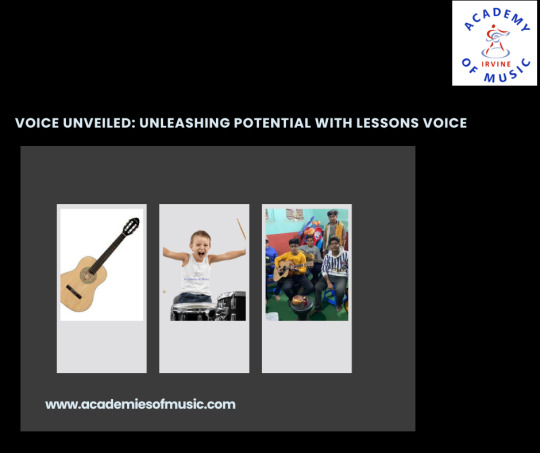
Drum lessons also emphasize the development of a strong sense of timing and rhythm, skills that are crucial for any musician. Drummers serve as the heartbeat of the band, providing the foundation for other instruments to build upon. As such, drum lessons instill a heightened sense of musical awareness, teaching students to listen to and synchronize with other musicians in an ensemble setting.
Beyond the technical aspects, drum lessons often delve into the creative and expressive facets of drumming. Students are encouraged to explore their own unique style, experiment with different drumming techniques, and develop the ability to improvise and adapt to various musical contexts. This creative exploration not only enhances the drummer's personal expression but also contributes to the overall dynamics and energy of a musical performance.
For aspiring drummers, lessons are not limited to the physical act of playing the drums. Many instructors incorporate music theory and notation into their lessons, teaching students to read and interpret drum sheet music. This additional knowledge equips drummers with the skills to collaborate with other musicians, follow written arrangements, and contribute meaningfully to a broader musical ensemble.
Drum lessons cater to individuals of all ages and skill levels. For young beginners, drum lessons provide an exciting and engaging introduction to the world of music. Many instructors use interactive games, rhythmic exercises, and creative approaches to make learning the drums enjoyable for children. For adults, drum lessons offer a fulfilling and stress-relieving outlet for self-expression, making it never too late to pick up drumming as a hobby or a serious pursuit.
The advent of technology has also influenced the delivery of drum lessons. Online platforms and video tutorials allow students to access lessons from experienced instructors around the world. This flexibility accommodates busy schedules and provides drummers with the convenience of learning in the comfort of their own practice space.
In conclusion, drum lessons are an enriching and transformative experience for anyone passionate about rhythm and percussion. Whether you're a beginner exploring the world of drumming or an experienced musician looking to refine your skills, drum lessons offer a structured and enjoyable pathway to musical mastery. Through expert guidance, creative exploration, and a focus on rhythm and timing, drum lessons empower individuals to become not just drummers but vital contributors to the musical tapestry.For more details visit our website : www.academiesofmusic.com
#piano class near me#singing class near me#singing coaches near me#piano lessons#music school#drum class near me#music lessons#musician lessons#vocals lessons near me#voice instructors near me#lessons of drums#drum lessons#lessons voice#piano lessons for kids#musical instruments for rent near me#instruments rentals near me#rental instrument near me#rent instruments near me#rent instrument near me#instrumental rentals near me#instruments for rent near me#instrument for rent near me#rent an instrument near me#violin music lessons#violin lesson#piano teachers#violin size chart#violin sizes chart#rent instrument#instrument rent
0 notes
Text


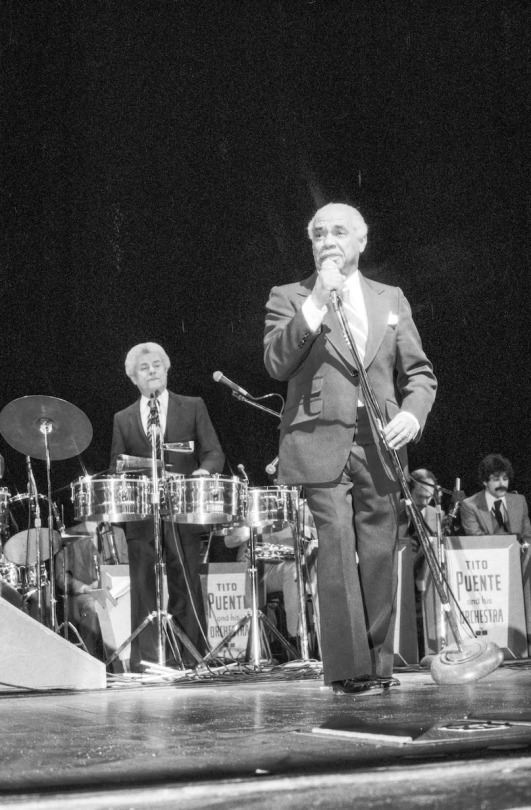
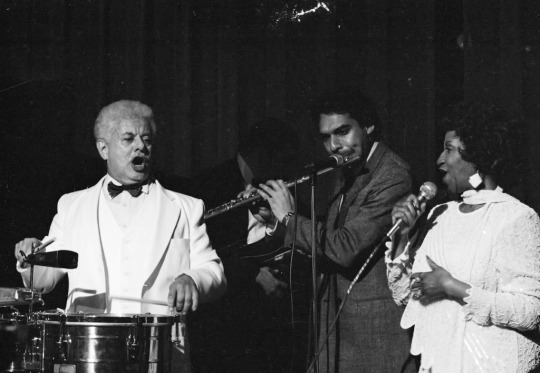

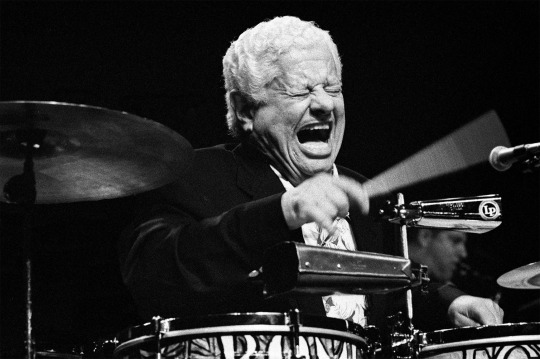




«Nosotros, los latinos, al incorporar la percusión, le dimos un ritmo más excitante al jazz».
- Tito Puente
Un día como hoy mayo 31 de 2000 muere a los 77 años de edad, en New York City, Ernesto Antonio Puente, mejor conocido como Tito Puente, percusionista estadounidense de origen puertorriqueño, discípulo de Mario Bauza, se adentró en los ritmos afrocubanos bajo la instrucción del gran Changuito Quintana, incursiono en el mambo, salsa, guaracha, pachanga, jazz afrocubano y jazz latino.
Entre sus mejores álbum se encuentra Live at Birdland, Salsa meets Jazz, Top Percussion, Dancemania, Para los rumberos, Golden Latín Jazz All Stars acompañado de destacadas figuras como Paquito D’Rivera, Claudio Roditti, Giovanni Hidalgo, Dave Valentín, Andy González, Mongo Santamaría entre otros, así como un destacado proyecto para la marca de instrumentos musicales LP llamado Latin Percussion Jazz Ensemble acompañado de importantes músicos como el pianista Jorge Dalto, Carlos Patato Valdés.
#jazz#latínjazz#latin jazz#afrocuban jazz#afrocubanas#tito puente#percussion#Percussion player#timbales#timbal player
5 notes
·
View notes
Text
The genius of Chick Corea (an analysis - sheet music incl.)
The genius of Chick Corea (an analysis - sheet music, incl.)Chick Corea's short biography
Best Sheet Music download from our Library.Chick Corea's piano styleA. Technique
B. Rhythm
C. Melodic Characteristics
D. Harmonic Characteristics
It Could Happen To You (Live / Show 1 / January 3, 1998)
Chick Corea's Arrangement and Solo on “It Could Happen to You”
Please, subscribe to our Library. Thank you!
The genius of Chick Corea (an analysis - sheet music, incl.)
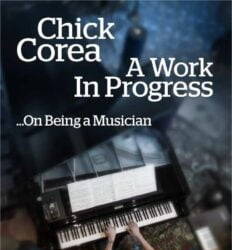
Chick Corea's short biography
Armando Anthony Corea was born June 12, 1941 in Chelsea/ Massachusetts. His father, a jazz trumpet player, was his first musical inspiration. After several years of exploring the piano and the drum set, Chick started piano lessons with concert pianist Salvatore Sulo.
During short stints at Columbia University and Juilliard, he decided to pursue a professional career as jazz musician and took residence on Seventy First Street in New York. Soon he was busy playing with Mongo Santamaria, Willie Bobo, Herbie Mann, Elvin Jones, Stan Getz, and many others. With trumpeter Blue Mitchell Chick recorded his first original composition, called Chick's Tune on Blue Mitchell's LP “A Thing To Do”.
The first LP under Corea's own name, “Tones for Joan's Bones”, recorded in 1966, features Joe Farrell (saxes), Woody Shaw (trumpet), Steve Swallow (bass), and Joe Chambers (drums) playing a mixture of Latin, Bop, and Free Styles. More Bebop oriented tunes are recorded on the 1968 follow-up “Now He Sings, Now He Sobs” with Miroslav Vitous on bass and Roy Haynes on drums.
Shortly thereafter, Corea rose to international fame during a three-year stint with the Miles Davis group. With bandmates Dave Holland (bass), and Jack DeJohnette (drums), Corea started exploring the world of Free Improvisation on the recording “Is”. Several recordings with his group “Circle” document further experimentation with free forms. After a
return to more melodic lines and harmonic progressions with his solo piano recordings “Improvisations I & II” for the ECM label, Corea decided to leave Circle and focus back on structure, melody, and harmony. In his Forward to the Warner Bros. publication “The Jazz Styles of Chick Corea”, he explains his change in direction:
“In 1971, an incredible change occurred in my life, directly stemming from some initial studying I did of the works of L. Ron Hubbard, the founder of Scientology, “says Chick. “The result was a seemingly new-found but actually old and hidden goal I had for a long time: to create and communicate the music I love.”
The realization of this goal became his group “Return to Forever”, one of the most influential groups of the Jazz Rock Fusion era. The original members include Stanley Clarke (bass), Joe Farrell (saxes, flute), Flora Purim (vocals, percussion), Airto Moreira (drums, percussion), and Chick Corea (keyboards).
Their self-titled debut and the follow-up record “Light as a Feather” emphasize the fusion of jazz traditions with Latin-American music. The result are some of the most melodic compositions of jazz, such as Corea's probably most famous piece “Spain” or the playful “Sometime Ago.” After replacing Florim and Moreira with Bill Connors (guitar) and Lenny
White (drums) in 1974, the group became one of the forerunners of electronic jazz.
RTF's progressive mixtures of jazz concepts, rock and latin-american rhythms, and classical forms are documented on “The Hymn of the Seventh Galaxy” and with guitar virtuoso Al DiMeola on “Where Have I Known You Before”, “No Mystery”, and “Romantic Warrior”. The group went through several personnel changes until it's final break-up in 1980, including a 13-piece ensemble with strings and Gayle Moran, Corea's wife, on vocals. The various incarnations and Corea's extended compositions and arrangements are documented on “The Leprechaun”, “My Spanish Heart”, “Mad Hatter”, “Friends”, and “Secret Agent”.
The years until 1985 were filled with a wide variety of activities, ranging from several duo projects with Herbie Hancock, Gary Burton, John McLaughlin, and Paco di Lucia
among others, over acoustic collaborations with Michael Brecker, Eddie Gomez, and Steve Gadd on “Three Quartets”, to performing Mozart's Double Concerto with Friedrich Gulda and the Concertgebouw Orchestra.
Inspired by his classical performances, Corea composed his own concerto for piano and orchestra and released his Children's Songs, a collection of 20 short piano pieces reminiscent of Darius Milhaud's ragtime and tango influenced piano music.
By 1985, Corea joined forces with young virtuosos John Patitucci (bass), Dave Weckl (drums), and Scott Henderson (guitar) to form The Chick Corea Electric Band. In an
interview for Keyboard Magazine, July 1986, Corea explained that the use of electronic instruments opens up new possibilities of expression and allows him to
communicate with sounds currently familiar to a broader audience.
A recording contract with the GRP label resulted in a series of tours and recordings, such as the self-titled debut, the grammy winning “Light Years” with Eric Marienthal (saxes),
and Frank Gambale (guitar), “Eye of the Beholder”, “Inside Out”, and “Beneath the Mask”.
The Electric Band era concluded in 1993 with the release of “Paint the World”, featuring the Electric Band II with Gary Novak (drums), Jimmy Earl (bass), Mike Miller (guitar), and Eric Marienthal (saxes).
During the 90ies, many jazz musicians discarded the world of electronics and focused on using acoustic instruments and interpreting the traditional standard repertoire. Already during the late 80ies, Corea, Patitucci, and Weckl, had toured and recorded as an acoustic trio. Recording now for his own label, Stretch Records, Corea returned to his acoustic roots with “Time Warp”, a tribute to Bud Powell, and duo
recordings with Bobby McFerrin and Gary Burton, recorded between 1994 - 1997.
In addition, he further explored the world of classical music with “The Mozart Sessions”, conducted by Bobby McFerrin. Most recently Corea formed the sextet “Origin”, a new outlet for his compositions and arrangements.
Corea never seems to sit still, always looking for new, unexpected adventures. But even in the most diverse projects, such as his free-style recordings with “Circle”
compared to the jazz fusion of the “The Chick Corea Electric Band,” Corea's piano style is easily recognizable and well-defined. While incorporating the traditions of jazz, the ultimate goal of any jazz musician is to develop a personal, recognizable approach to playing by defining some basic conceptual principles.
Those principles provide the unifying threads throughout Corea's eclectic projects. Following is a discussion of some of those characteristic of a great artist.
Chick Corea's piano style
A. Technique
- In one of his poems from his music poetry, Chick writes: “Discipline your body, discipline your instrument…”. His clean and clear attack and mastery of his instrument demonstrates such principles.
- His articulation is always precise and clean no matter if he plays a Steinway grand piano, a Fender keyboard, or his Yamaha strap-on keyboard. Corea's keyboard solo on “Got A Match” on The Chick Corea Electric Band is exemplary for his clear articulation even at extreme speeds.
- Corea's touch can be very powerful, using the piano foremost as a percussion instrument. One example is on An Evening With Herbie Hancock, where he plays the
vamp figure of “La Fiesta” at the beginning so forceful and with minimal key contact, that it sounds more like a drum groove than a piano vamp.
- On the other hand, he can be very sensitive and tasteful. Some examples are his romantic soloing on “Where Have I Known You Before” on the similarly titled album and his interpretations of his own “Children's Songs.”
- He doesn't limit his palette of sounds to conventional means of playing the piano keys. Especially during duo or trio performances, one can frequently observe Corea
plucking the strings inside the piano and experimenting with different ways of preparing the strings. Such experimentation were personally witnessed during his
concerts at the 1996 IAJE convention, and can also be heard on “Fragments” and “Duet for Bass and Piano No. 2” on the record Circling In.
- Chick Corea's use of baroque-like embellishments are heard rather frequently in his playing. Sometimes he'll just fill out melodic intervals chromatically, as in the following example.

His complete independence of right and left hand is also a strong component of Chick Corea's technique. Such independence enables him to provide bass ostinatos and rhythmic accents complimentary to right-hand melodies. A short excerpt from his solo on “La Fiesta” exemplifies this ability.

B. Rhythm
- Chick Corea's preference for Latin-American rhythms has become a trademark of his style. The choice of song titles, such as “La Fiesta,” “Spain,”” My Spanish Heart,” “Samba
Song, “or “Señor Mouse” already indicate such preferences. His piano accompaniments often combine Latin-American rhythms with jazz harmonies.
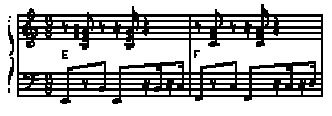
La Fiesta (Takase, 1979)
2. Sophisticated rhythmic interplay and precise timing are very prominent in Chick Corea's comping and soloing. Being an accomplished drummer, he has a wide repertoire of
rhythms and the ability to execute them with confidence and perfect timing. Such rhythmic variety adds interest and excitement to his music.
3. Often, his syncopation and his ability to play different rhythms with each hand create polyrhythmic effects.
The rhythmic organization of his melodic lines, often referred to as phrasing, also displays his rhythmic mastery and versatility. Although the typical strings of eighth notes dominate Chick Corea's soloing, he knows how to place rests and other rhythmic values effectively to create logical, congruent lines.
C. Melodic Characteristics
One main aspect of jazz improvisation is to create interesting melodic lines in relation to a repeating harmonic structure. Therefore, the pitch content of melodic lines needs to be discussed in reference to the underlying harmonies. As a result, some aspects in the analysis of melodic and harmonic elements will overlap.
The melodies of Corea's compositions are very lyrical and memorable, many of his songs have become part of the standard repertoire of jazz musicians. Some examples
are “Spain,” “Windows,” or “Humpty Dumpty”. During his improvisations, he combines such lyricism with complex rhythmic and harmonic twists.
Some of his most lyrical improvisations are captured in his “Piano Improvisations I & II” and his solo rendition of “Where Have I Known You Before.”
Rooted very much in the Bebop tradition, Corea's improvised lines are dominated by long strings of eighth notes shaped in the sinoid waveforms. Especially at faster tempos, such dominance of eighth note values is apparent.
Corea often prefers lydian and altered scales to add tension and color to his improvised lines. Especially, diminished scales (half step/ whole step alternating) used in relation to dominant chords can be frequently detected in his solos.
Jazz musicians often develop favorite melodic patterns and runs that make their style recognizable. Corea often uses a chromatic ascending pattern and short embellishments at the beginning of lines.
D. Harmonic Characteristics
Studying the classical literature and composition has influenced Corea's harmonic vocabulary. Similarities to the harmonic innovations of the French romantics such as
Claude Debussy and Maurice Ravel can be detected. Corea displays preferences for wide, open sounds with frequent uses of Ma7#11 chords.
During his years with John Coltrane, pianist McCoy Tyner developed a new harmonic approach by using voicings based mainly on the interval of a fourth. This technique became the essence of the modern piano sound. Similar voicing techniques can be detected in Corea's playing.
Corea's harmonic progressions often depart from the traditional functional harmony, which depends mainly on the II-V-I relationship. One technique for harmonic
expansion is the use of poly chords, which consist of harmonies with foreign bass notes or two harmonies layered on top of each other.
Other techniques for harmonic expansion are the use of ostinati and pedal points. Both techniques are apparent in Corea's compositions and performances. Pedal points provide a suspended feel to the harmonic movement and create tension to be released with the departure from the pedal point.
Especially in his cycle of “Children's Songs”, Corea frequently uses ostinati to create accompaniments.
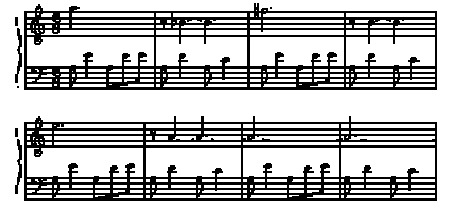
Children's Songs No. 1
Finally, Corea often employs parallel movement of harmonies of the same quality. This is another technique to avoid functional harmony while still creating logical
harmonic movement.
It Could Happen To You (Live / Show 1 / January 3, 1998)
https://www.youtube.com/watch?v=gyJrmaoHN7A
Chick Corea's Arrangement and Solo on “It Could Happen to You”
Please, download a transcription of Chick Corea's arrangement and two solo choruses on the standard “It Could Happen to You” by Jimmy Van Heusen and Johnny Burke (from the songbook "Chick Corea Plays Standards")
Chick-Corea-Plays-Standards-1 “It Could Happen to You”Download
This performance with Corea's most recent group “Origin” was captured in February 1998 during an engagement at New York's jazz club “Blue Note”. Many of Corea's style characteristics discussed earlier are apparent in this transcription.
The following analysis will focus on these special characteristics. “It Could Happen to You” is a 32-bar song, composed in two similar 16-bar sections. After a rubato solo piano introduction, Corea states the head, supported by Avishai Cohen on drums and Adam Cruz on drums. Steve Davis on trombone, Bob Sheppard on tenor sax, and Steve Wilson on alto sax join for the last four measures.
In order to reinforce his liberal treatment of the melody, Corea adds, deletes, and substitutes some of the original harmonies. In measure 3, Corea adds an Am passing
chord, then proceeds chromatically up to C. Furthermore, a string of chromatically descending, parallel dominant chords substitutes for the original tonic - subdominant progression in measure 5 and 6.
Instead of the regular ii-V Turnaround in measures 15 and 16, Corea harmonizes the melody in triads to a step-wise descending bass line, a technique discussed earlier under harmonic characteristics. Finally, he suspends the resolution to the tonic in measure 31 by laying a C-pedal point for the final 6 measures of the head.
Corea begins his solo with a melodic sequence, emphasizing the #11 of F-Major in measure 37. The sequence continues with embellishments until measure 41. For the turnaround in measure 46 and 47, Corea chooses to use a D-Major Scale, brightening up the sound of the F-Major harmonic basis from one flat to two sharps.
In order to lead back to the F-Major tonic, Corea moves up chromatically, implying E-Major during measure 48. Similar to the tonic-subdominant substitution with a string of
dominant chords during the head in measure 21-24, Corea plays a descending, chromatic sequence from Bb13 to G13 in measure 54.
He completes his first chorus with a C-pedal point. During m. 61-64, Corea melodically implies a progression of Dm7, Ebm7, Ab, G7b9 over the C-pedal point as a turnaround to the F-Major tonic in m.65.
During the second chorus, Corea concentrates more on rhythmic aspects for his improvised lines. In m. 67/ 68, he crosses the bar lines with a hemiola, leading to a syncopated repetition of C's doubled at the octave over the course of the following three measures. Echoing the thought, Corea states a series of B's in measure 75 and 76.
In relation to the F Major harmony in measure 75 , B is the #11, one of Corea's favorite harmonic option to brighten up major chords. Again, he implies a series of triads over an ascending bass line to close the first half of the second chorus. Block harmonies characterize the improvisational approach for the second half of the chorus. Instead of the C-pedal point, Corea increases tension and intensity by leading into the third solo chorus with an ascending B-Major scale, accented by syncopated, ascending fourths in the left hand.
In closing this discussion of Corea's piano style, the following basic principles can be extracted from the analysis. With a clear touch, a clean technique, and a very strong sense of rhythm, Corea is well-equipped to realize his quest for communication through his music.
Some of his most prevalent melodic techniques are the frequent use of embellishments, lydian and altered scales, and some typical chromatic patterns. Harmonically, Corea frequently uses voicings based on the interval of a
fourths, poly chords, non-functional progressions, pedal points, and ostinati.
In summary, Corea's artistry is based on a strong command of his instrument and contemporary harmonic techniques. Naturally there is a deeper level to artistry than just the surface of technique, rhythm, melody, and harmony. Personal attributes such as creativity, inventiveness, spontaneity, or flexibility are just as important as musical
characteristics.
Nevertheless, the previous analysis can be helpful for students of jazz piano and jazz in general in developing their own, personal concepts. Not only jazz performers may benefit from such an analysis, but also listeners of jazz in order to develop a stronger appreciation and understanding of one artist's accomplishments.
Read the full article
0 notes
Audio
Malo's second album was cut with a lineup that had been reorganized following their debut. It's a little slicker than their first LP and the material isn't as strong. It's nonetheless a strong and invigorating rock/Latin jazz fusion, boasting some really hot playing, both in the ensemble work and improvisation. The six cuts, save one, all run more than five minutes, the closing "Latin Boogaloo" approaching ten minutes in length. Often this is closer to rockified salsa music than it is to the salsified rock music of lead guitarist Jorge Santana's brother, Carlos Santana. Occasional dives into sentimentality, as on the opening part of "I'm for Real," with its floating violin and percussive tinkles, are more than compensated for by some smoking Santana leads, particularly on the hyperactive "Held." "I'm for Real" was the cut most likely to follow up on the success of their "Suavecito" single, both because it was sung in English and because it had traces of the same kind of smoochy soul. Again, it wasn't too typical of the album as a whole, which combined several tributaries of pop with imagination and high levels of musicianship. Sometimes this was stretched out with jamming much more intelligent and fully thought-out than most lengthy, instrumental-oriented rock cuts, particularly on "Latin Boogaloo."
23 notes
·
View notes